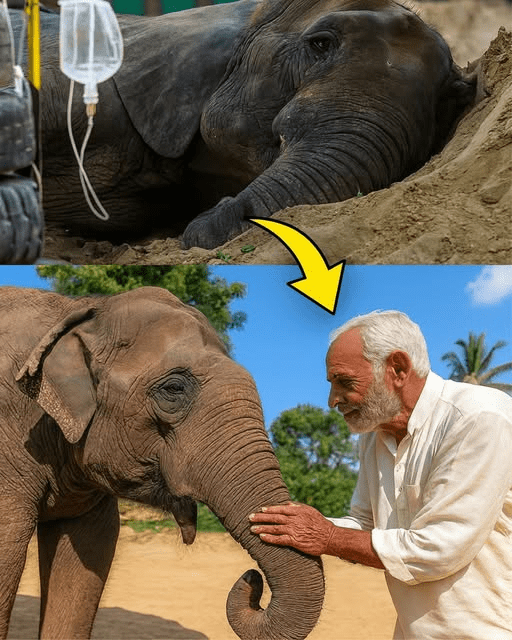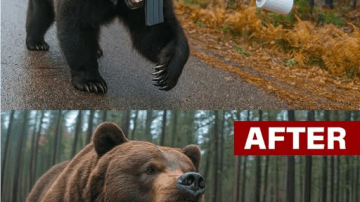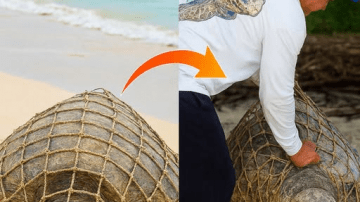The air in Karachi was still that morning—heavy, humid, and filled with an uneasy silence. Beneath the only tree in her concrete enclosure lay Noor Jehan, a 17-year-old African bush elephant whose life had been reduced to quiet suffering. Once powerful and curious, she now barely moved. Her vast body, once meant to roam miles of savannah, was trapped beneath the shadow of captivity.

She had spent weeks dragging herself forward with her front legs, her back legs useless from injury. Her trunk, once a graceful instrument of strength, now reached weakly for food or comfort. The volunteers who stood nearby could see what the public had not wanted to see—Noor Jehan was dying.
On April 22, her struggle ended. And with it, something inside thousands of hearts broke open.
A Life Stolen Before It Began
Noor Jehan’s story didn’t begin in Pakistan—it began in the wilds of Tanzania. There, she was born into a herd that moved with the rhythm of the seasons, a family bound by matriarchal wisdom and deep emotion. Like all elephants, she learned to follow her mother’s footsteps, to play in rivers, to communicate through low rumbles that traveled through the ground.
But when she was only a few years old, that life was stolen from her. She was captured—taken from her herd and sent thousands of miles away under the label of “conservation.”
What was called preservation was, in truth, captivity.
Along with three other elephants, Noor Jehan was brought to Pakistan to live in Karachi Zoo. The idea, officials said, was to educate the public about wildlife and inspire care for endangered species. But behind the walls, the reality was very different.
The Concrete Prison
In her new home, Noor Jehan’s world shrank from open plains to concrete walls. The ground beneath her feet was hard and hot, far from the soft soil of her homeland. There was no grass to graze on, no river to bathe in, no herd to guide her. Only the constant sound of city traffic and the endless buzz of human curiosity.
She shared her enclosure with another elephant, Madhubala—her only companion in a space too small for either of them. For years, they performed for visitors, swaying under the weight of boredom and confinement. The movement that some mistook for calm was, in truth, a sign of stress.
Noor Jehan’s life was measured in the rhythm of chains and the monotony of days that looked exactly the same.
The Pain That Could No Longer Be Ignored
It began subtly—an ache in her back, a limp in her step. But over time, Noor Jehan’s condition worsened. Her hind legs began to fail her, the result of untreated injuries and years of standing on hard surfaces.
By the time the public noticed, she could barely stand.
Videos began circulating online: Noor Jehan lying helplessly in her enclosure, trying to push herself up with her front legs, her massive body collapsing under its own weight. She reached out with her trunk, as if asking for help, her eyes dull with exhaustion.
People wept watching those clips. Others grew angry.
For too long, her pain had been dismissed—until animal welfare groups, including Four Paws International, intervened. They demanded access to treat her and brought in a team of veterinarians from abroad.
But when they arrived, they found her condition far worse than expected.
The Battle to Save Her
For days, the rescuers worked tirelessly. They cleaned her wounds, gave her pain relief, and tried to build a support system to help her stand. Volunteers came from around the city, bringing sugar cane, fruit, and prayers. Some whispered soft words to her, as if she could understand that she wasn’t alone anymore.
But time was against them. Noor Jehan had spent too many years without proper care, and her body was failing. The infection had spread, her spine was damaged, and her will to fight was slipping away.
When she lay beneath the lone tree that final morning, her caretakers knew. She closed her eyes as the sun rose over Karachi, her breath slowing. And then, with a final exhale, Noor Jehan was gone.
A City in Mourning
The news of her death spread across Pakistan within hours. People who had never stepped foot in the zoo found themselves grieving. Candlelight vigils were held outside her enclosure. Children left flowers. Artists painted her portrait.
But the grief quickly turned into something stronger—outrage.
“How could this happen?” people demanded. “Why was she left to suffer for so long?”
Activists and conservationists spoke out fiercely. Among them was Zulfikar Ali Bhutto, who condemned the system that had allowed her to die in pain.
“She was caged, starved, and exploited,” he said. “This wasn’t conservation—it was cruelty disguised as education.”
The Call for Change
In the wake of Noor Jehan’s death, the Pakistani government faced mounting pressure. International organizations urged authorities to shut down Karachi Zoo entirely, calling it a “place of suffering, not sanctuary.”
Four Paws International proposed relocating Madhubala—the surviving elephant—to a safe sanctuary where she could live out her life with proper care, natural surroundings, and freedom from chains.
For the first time in decades, the conversation about animal welfare in Pakistan reached national headlines. Noor Jehan’s story had done what no press release or protest could—it made people feel.
Her suffering became impossible to ignore.
The Symbol of Something Greater
Today, Noor Jehan’s enclosure stands empty. The tree that shaded her in her final hours casts a long, lonely shadow over the cracked ground. Visitors who walk past can still see the marks where she once lay, where her caretakers stood vigil in her last moments.
She came into captivity as a trophy—something meant to impress and entertain. But in death, she became something far more powerful: a symbol of conscience.
Her story has been retold in classrooms, on television, in documentaries, and in quiet conversations between strangers who never knew her but felt her pain. She has become a question—one that lingers in every zoo, every circus, every place where wild animals are made to live behind bars.
What do we owe those we claim to protect?
The Legacy She Left Behind
For Madhubala, plans are now in motion to move her to a new sanctuary where she can live without chains, free to walk on grass and bathe in water again. For the people of Karachi, Noor Jehan’s death has sparked an awakening.
Change does not come easily, but compassion, once stirred, rarely fades.
Noor Jehan’s story is not just about an elephant. It is about all the voiceless beings who depend on human mercy. It is about the cost of indifference—and the power of awareness.
A Final Image
In the end, all that remains of Noor Jehan is memory. The sound of her trunk brushing against the ground. The sight of her lying under that solitary tree. The way she fought, silently, until she could fight no more.
But even in her stillness, she continues to move hearts.
Because Noor Jehan’s life—and her suffering—remind us that compassion is not measured by our words, but by our willingness to act. She showed the world the price of captivity, and in doing so, she became something eternal: a voice for those who cannot speak.
The tree still stands in her enclosure, its branches stretching toward the sky as if reaching for her spirit. Beneath its shade, the earth holds the echo of her final breath—a reminder that even in loss, there can be awakening.
Noor Jehan entered this world as one of the wild’s most magnificent creatures. She left it as a symbol of hope, change, and the enduring truth that every life, no matter how forgotten, deserves dignity.


